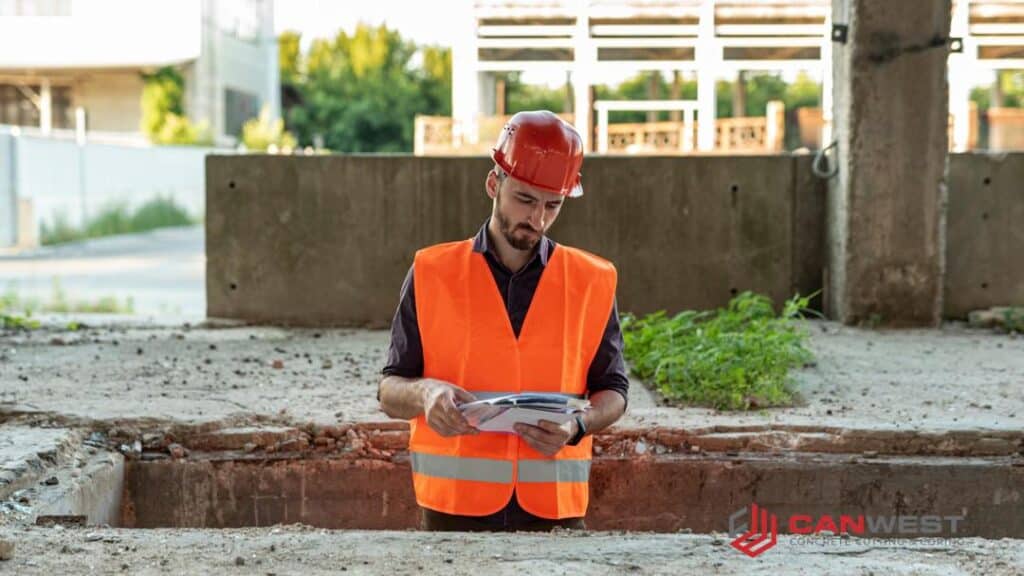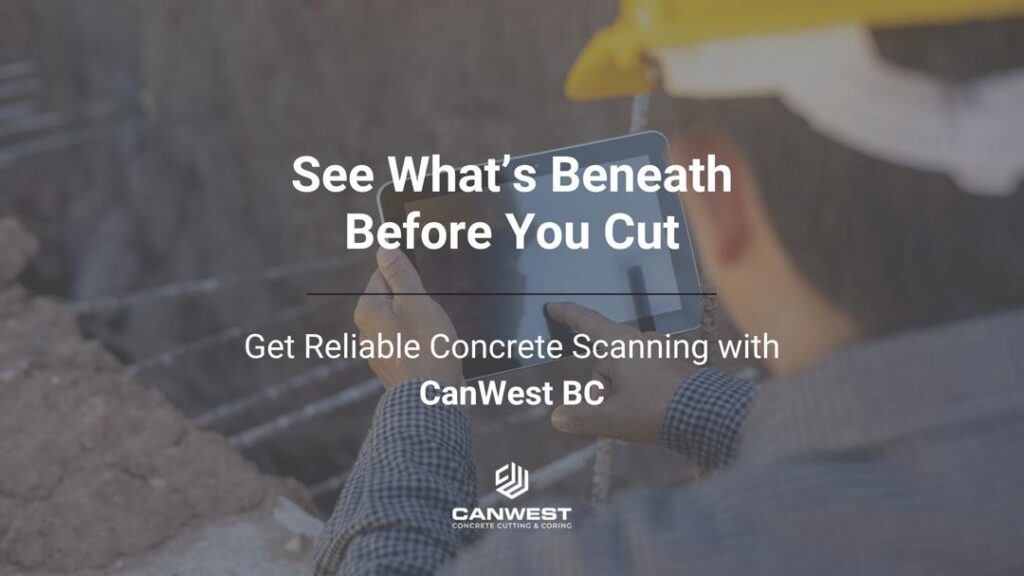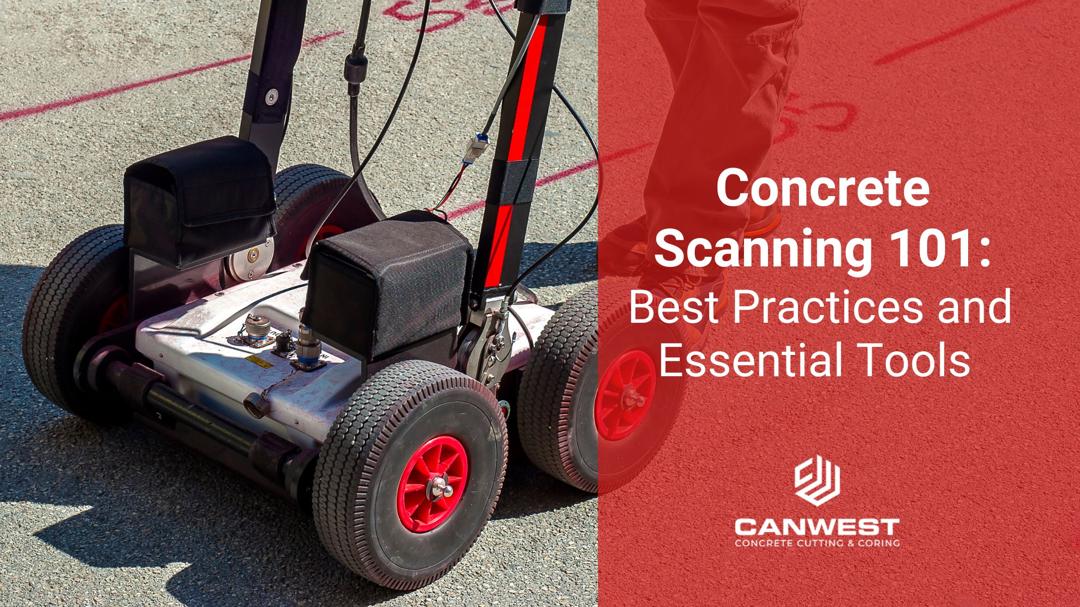At CanWest Concrete Cutting & Coring, we understand the stakes. When you're working on a multi-story building or a critical infrastructure project, there’s no room for guesswork—especially when it comes to what lies beneath the concrete surface. That's where concrete scanning becomes not just useful, but absolutely essential.
From ensuring embedded electrical systems and piping are precisely placed, to preventing structural setbacks and safety hazards, concrete scanning is one of the most critical phases of any modern construction project.
What is Concrete Scanning?
Concrete scanning is a non-destructive method used to detect and map embedded elements within concrete structures. This includes rebar, post-tension cables, conduit, and voids. The goal is to avoid cutting or coring into hidden hazards—saving time, money, and potentially lives. According to the Federal Highway Administration, Ground Penetrating Radar (GPR) is a proven non-destructive technique widely used to assess the condition of concrete structures, such as bridge decks.
It’s not just about finding what’s inside; it’s about making smart, data-informed decisions before you even touch a saw or a drill.
Why Concrete Scanning is Essential
Every project we take on at CanWest Concrete Cutting & Coring starts with one central priority: precision. In multi-story projects with embedded piping and electrical systems, one small misalignment can snowball into costly, time-consuming complications. Concrete scanning allows us to verify that everything is exactly where it needs to be—before pouring, cutting, or coring begins.
Mistakes in this phase aren’t just inconvenient—they’re dangerous. Severing a post-tension cable or striking an electrical conduit can cause injuries and damage critical infrastructure. Scanning helps us protect people, timelines, and budgets.
Technologies Used in Concrete Scanning
When it comes to scanning, not all tools are created equal. At CanWest Concrete Cutting & Coring, we utilize advanced technologies to ensure optimal accuracy and reliability.
Ground Penetrating Radar (GPR)
The most widely used technology in our toolkit is Ground Penetrating Radar (GPR). This GPR scanner emits high-frequency radio waves into the concrete and measures the reflected signals. It’s effective in identifying:
- Rebar and mesh
- Post-tension cables
- Electrical conduits
- Voids and anomalies
- Subsurface features
As a non-destructive method, GPR scanning provides high-resolution imaging without damaging existing structures. It's particularly effective in identifying variations in material properties, offering insights into penetration depth and signal reflection to guide construction planning.
Electromagnetic Induction (EMI)
While GPR remains the most practical tool for most environments, in some cases, additional technologies like electromagnetic induction (EMI) may be considered. EMI is useful in identifying metallic objects based on signal emission and can complement GPR data under certain conditions. However, GPR remains our primary tool due to its flexibility, speed, and safety benefits.
At CanWest Concrete Cutting & Coring, we’re proud to offer industry-leading concrete scanning services that combine cutting-edge technology with expert-level interpretation to ensure your project proceeds without costly surprises.
Applications of Concrete Scanning
The utility of concrete scanning spans far beyond just structural verification. It plays a pivotal role in:
- Multi-story commercial construction
- Industrial facility upgrades
- Airport runway and terminal maintenance
- Bridge inspections
- Subway tunnel repairs
- HVAC and plumbing installation
- Renovation projects
At CanWest Concrete Cutting & Coring, we specialize in multi-story concrete projects where embedded piping and electrical systems must be flawlessly coordinated. Our team has successfully applied these scanning methods across a wide range of commercial and residential projects, delivering tailored solutions regardless of scale or complexity. Without scanning, these installations would be left to chance—and in our world, chance is not an option.
Preparing for a Concrete Scan
Preparation directly influences the accuracy and efficiency of the GPR concrete scan process. Before scanning begins, our team conducts a detailed preliminary assessment to understand the project's requirements and scope. Clients can take several steps to help streamline this phase.
Site Assessment
A thorough review of the work area, including layout, foundation condition, and any existing structures. This helps our technicians anticipate scan limitations and develop a tailored scanning strategy. It also provides insight into areas where deeper investigation may be required.
Surface Accessibility
Clear any obstructions and ensure that the scanning surface is clean and dry. This helps optimize signal penetration and data quality. Removing loose materials or equipment also reduces the risk of physical interference with the scanning equipment.
Identify Modifications and Obstacles
Document any recent modifications, embedded systems, or potential obstacles that could interfere with scanning. Providing this information in advance helps our technicians avoid surprises during scanning. It also improves the accuracy of data interpretation.
Define the Scope of the Scan
Clearly communicate the intended outcome—whether it's locating rebar, conduits, voids, or planning a renovation project. A well-defined scope ensures our team uses the right tools and techniques. It also allows for better coordination with other trades on-site.
Coordinate with Project Timeline
Inform our team about scheduling requirements to integrate seamlessly into your workflow. Early communication allows us to align our scanning services with other project milestones. This reduces delays and avoids conflicts with other ongoing work.
Best Practices for Accurate Results
Over decades of hands-on experience, our team has developed a refined approach to ensure scanning delivers maximum accuracy. Here’s what we recommend:
1. Preparation is Key
A clean, accessible surface improves signal quality. Remove debris, standing water, and loose materials before scanning.
2. Calibrate Your Equipment
We never skip calibration. Even the most sophisticated GPR scanners need fine-tuning for each unique project.
3. Understand Your Material
Concrete type, density, and moisture levels all affect scan quality. Our technicians always adjust parameters accordingly.
4. Use Grid Mapping
We create a grid across the scan area to document results systematically. Using grid mapping repeatability and data integrity.
5. Don’t Rush the Interpretation
The scan is only half the job; interpreting the data is where the real skill lies. Our experts carefully analyze scans to provide clear, actionable insights.

Common Challenges in Concrete Scanning
Even with the best tools, scanning concrete is not without its challenges. There are a few common issues we often tackle. According to the International Atomic Energy Agency, factors such as material composition, slab thickness, moisture content, and site-specific environmental conditions can significantly influence the performance of Ground Penetrating Radar (GPR). Understanding these limitations is critical to adjusting scanning techniques and ensuring accurate results.
Interference from Metallic Materials
High-density rebar or steel mesh can distort signals. When metallic components are densely packed within a slab, it becomes more difficult for GPR signals to accurately identify individual elements. This can lead to overlapping reflections and false positives, requiring experienced technicians to carefully interpret results.
Moisture Content
Wet concrete can reduce scan clarity. Moisture within the slab alters the dielectric properties of concrete, affecting how radar signals travel and return. This may lead to weaker signal strength or unclear images. Our team adjusts equipment settings accordingly to mitigate this impact and ensure scan reliability.
Depth Limitations
GPR scanners have limits; very thick slabs may require deeper frequency adjustments or alternate approaches. While GPR is highly effective for standard slab thicknesses, extremely deep concrete structures may reduce its effectiveness. In such cases, we employ specialized equipment or techniques to maximize scan depth while preserving data quality.
Access Constraints
Tight spaces or uneven surfaces require specialized techniques and tools. Not every job site offers easy access—especially in renovation projects or existing structures. Scanning in stairwells, corners, or narrow corridors demands flexible setups and operator agility. Our field teams are trained to handle these conditions safely and efficiently.
Another critical challenge is data interpretation across complex slab compositions or layered structures. Our experienced technicians use industry-leading software and years of training to read signal amplitude and reflection consistency, ensuring high-confidence results even in the most challenging environments.
Moreover, clients sometimes underestimate how frequently construction plans change mid-project. Modifications not reflected in early drawings can throw off initial assumptions. That’s why our scanning process isn’t just a one-time step—it’s a continuous layer of verification that adapts to the evolving reality of construction work.
How to Interpret Concrete Scanning Data
Interpreting a GPR scan isn’t just about looking at a screen and spotting lines. It’s a detailed process of understanding patterns, amplitudes, and anomalies. At CanWest Concrete Cutting & Coring, our seasoned technicians translate this data into meaningful layouts that guide safe and effective work.
A strong interpretation requires a blend of technological skill and field experience. Our specialists often cross-reference GPR data with visual inspection findings and structural documentation. This dual-layer verification process increases accuracy, reducing risks before heavy machinery is even turned on.
Accuracy and Limitations
While GPR scanning is incredibly effective, it’s essential to understand its limitations. Certain materials, environmental conditions, and slab configurations can impact data quality. That’s why expertise matters. Our team knows how to navigate these variables and deliver the most accurate possible results.
No tool is perfect, but when paired with expert knowledge, GPR scanning becomes a powerful safeguard in both new construction and renovation work. By setting realistic expectations and planning for contingencies, we ensure our clients always have a reliable roadmap forward.
Benefits of Concrete Scanning
Investing in scanning services offers multiple advantages:
- Prevents Structural Damage
- Enhances Safety
- Avoids Utility Disruption
- Reduces Costly Delays
- Supports Compliance and Inspections
- Improves Project Planning and Documentation
- Enhances Collaboration Between Teams
- Provides Long-Term Asset Management Data
Choosing a Service Provider
Concrete scanning isn’t just about the equipment, it’s about the expertise. At CanWest Concrete Cutting & Coring, we combine cutting-edge tools with decades of field experience. Our technicians don’t just run scans; they interpret them, integrate them into your project, and ensure everything aligns with your construction goals.
As experienced concrete coring specialists, we understand how vital it is to coordinate scanning and cutting services seamlessly to reduce the risk of delays and structural damage.
When choosing a concrete scanning provider, ask questions about equipment types, technician experience, turnaround time, and reporting clarity. A reputable service provider like our team should offer not just scan results—but actionable insights that support broader project strategy.
How Concrete Scanning Works
The process typically follows this path:
- Site Assessment and Preparation
- GPR Scanning Using Grid Mapping
- Data Interpretation and Documentation
- Reporting and Client Collaboration
We pride ourselves on a transparent workflow. You’ll know what we’re seeing, what it means, and how it affects your next steps. Each report includes location coordinates, data overlays, key observations, and safety considerations. Our collaborative approach ensures that decision-making remains grounded in reality—not assumptions.

Specialized Grinding and Polishing Services
Beyond scanning, CanWest Concrete Cutting & Coring also offers grinding and polishing for industrial buildings, particularly in the Vancouver area. Cold concrete preparation is done 50% faster than traditional methods, streamlining workflows and reducing downtime. Our process also includes epoxy coating with rubber bits—perfect for surfaces like garage floors and high-impact zones.
Precision is crucial here, too. Grinding must be done before epoxy coating to ensure optimal adhesion and finish quality. This is a niche service that demands skilled execution—and that’s exactly what we deliver. Our experienced crew works efficiently with minimal disruption, helping clients stay on schedule without compromising on finish quality.
In addition to grinding and polishing, CanWest Concrete Cutting & Coring also provides demolition and excavation services, giving clients a comprehensive end-to-end solution under one roof.
Building with Confidence: The Power of Precision Scanning
Concrete scanning is not just a technical step—it’s a strategic one. It protects people, projects, and profits. At CanWest Concrete Cutting & Coring, we take this responsibility seriously. Our focus on accuracy, preparation, and interpretation ensures that our clients move forward with confidence and clarity.
Whether you're tackling a high-rise with embedded utility systems or a subway infrastructure upgrade, we’re here to ensure the groundwork (literally) is done right. Precision scanning isn’t a luxury, it’s a necessity. And when the stakes are high, there’s no better partner to trust than CanWest Concrete Cutting & Coring.
If you're ready to bring precision into your next project, contact us today. Let's make sure what’s beneath the surface supports everything above it.

